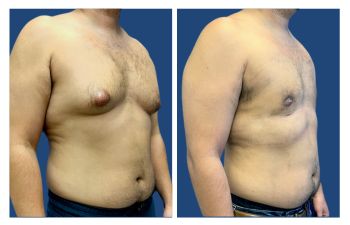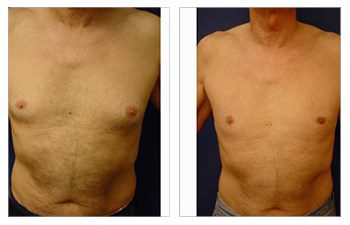Is the Rise in Man Boobs due to your diet?
Over the past two decades, there has been a notable increase in the incidence of gynecomastia, commonly referred to as “man boobs.” A study conducted in 2020 highlighted a staggering fivefold increase in this condition, raising concerns and sparking debates about its underlying causes. Gynecomastia, the feminization of the male chest, is often linked to elevated estrogen levels. However, the reasons behind this rise are more complex and multifaceted than previously believed.

Gynecomastia: The Feminization of the Male Chest
Gynecomastia is a condition characterized by the abnormal enlargement of breast tissue in men, often leading to a more feminine chest appearance. This condition results from an imbalance in hormones, where elevated estrogen levels stimulate the growth of mammary tissue and fat in the chest area. Traditionally, gynecomastia was attributed to factors like the overuse of marijuana during youth and natural hormonal changes that occur with aging, which tend to favor estrogen over testosterone.
The 2020 Study: Uncovering a Significant Increase in Gynecomastia
A 2020 study that reported a fivefold increase in gynecomastia over the past 20 years has led to a reevaluation of its causes. While previous assumptions focused on lifestyle choices and aging, these factors alone do not account for such a dramatic rise. This has prompted researchers to explore other potential contributors, particularly those related to modern dietary habits.
The Role of the Standard American Diet: Processed Foods and Hormone Disruption
Recent research suggests that the explosion in gynecomastia cases may be closely linked to the Standard American Diet, which is notoriously high in processed foods, red meat, sweets, dairy, and refined grains. These foods are often laden with additives, preservatives, and artificial ingredients that can disrupt the body’s hormone balance, leading to elevated estrogen levels.
Processed foods, in particular, are known to contain substances that mimic estrogen or interfere with the body’s natural hormone production. This disruption can cause an increase in estrogen relative to testosterone, contributing to the development of gynecomastia. The correlation between the rise in gynecomastia and the prevalence of Western diets provides a compelling explanation for this modern health issue.
Traditional vs. Modern Explanations: A Shift in Understanding Gynecomastia
The traditional explanation for gynecomastia primarily blamed lifestyle choices such as marijuana use and the natural aging process. However, the recent surge in cases suggests that these factors are not the sole contributors. The shift in dietary patterns, particularly the increased consumption of processed and hormone-disrupting foods, appears to play a more significant role in the condition’s prevalence today.
Understanding the connection between diet and hormone levels is crucial for addressing the rise in gynecomastia. By making informed dietary choices and reducing the intake of processed foods, men can potentially lower their risk of developing this condition.
The Hidden Dangers of Processed Foods: Additives, Preservatives, and Artificial Ingredients
In today’s fast-paced world, processed foods have become a staple in many households. Their convenience, long shelf life, and easy preparation make them an attractive option for busy individuals and families. However, beneath the surface of this convenience lies a hidden danger—processed foods often contain a variety of additives, preservatives, and artificial ingredients that can have serious implications for your health.
Understanding Processed Foods: What Are They?
Processed foods are those that have been altered from their natural state through various methods such as canning, freezing, drying, or adding chemicals. These alterations are designed to enhance flavor, extend shelf life, or improve texture, making these foods more appealing and easier to store. Common examples include packaged snacks, ready-to-eat meals, sugary cereals, and soft drinks.
Additives: Enhancing Flavor at a Cost
Food additives are substances added to processed foods to enhance flavor, appearance, or texture. While they make food taste better and look more appealing, many additives are synthetic chemicals that the body does not naturally process. Some common additives include monosodium glutamate (MSG), artificial sweeteners, and food colorings.
The use of additives in processed foods has raised concerns about their impact on health. For instance, MSG has been linked to headaches and other neurological symptoms in some individuals, while certain artificial colorings have been associated with hyperactivity in children. Although these effects vary among individuals, the long-term consumption of food additives may pose significant health risks in addition to elevating estrogen.
Preservatives: Extending Shelf Life, Reducing Nutritional Value
Preservatives are chemicals added to food to prevent spoilage and extend shelf life. They inhibit the growth of bacteria, molds, and yeasts, ensuring that food stays fresh for longer periods. Common preservatives include sodium benzoate, nitrates, and sulfites.
While preservatives are effective in keeping food safe to eat, they can also reduce the nutritional value of food. For example, some preservatives may break down vitamins and minerals, diminishing the overall health benefits of the food. Additionally, certain preservatives, such as nitrates used in processed meats, have been linked to an increased risk of cancer and elevation in serum estrogen.
Artificial Ingredients: Imitating Nature with Synthetic Substitutes
Artificial ingredients are synthetic substances that mimic natural flavors, colors, and textures. These ingredients are used to make processed foods more palatable and visually appealing. Common artificial ingredients include artificial flavors, artificial colors, and hydrogenated oils.
One of the main concerns with artificial ingredients is that they can be misleading. For example, artificial flavors can make processed foods taste like real fruit, even if they contain little to no actual fruit. Moreover, some artificial ingredients, such as hydrogenated oils (trans fats), have been linked to serious health issues like heart disease.
The Impact on Health: More Than Just Empty Calories
The cumulative effect of consuming processed foods laden with additives, preservatives, and artificial ingredients can be detrimental to health. These substances can contribute to various health issues, including obesity, heart disease, and metabolic disorders. Additionally, the overconsumption of processed foods often leads to a diet low in essential nutrients, further exacerbating health problems.
Research has shown that diets high in processed foods are associated with an increased risk of chronic diseases. The combination of synthetic chemicals and a lack of nutritional value creates a scenario where the body is deprived of what it needs to function optimally while being exposed to potentially harmful substances.
The Rise in Man Boobs due to your Diet Summarized
In conclusion, while the convenience of processed foods is undeniable, it is important to be aware of the potential health risks associated with additives, preservatives, and artificial ingredients found in the Standard American Diet.
Unfortunately, these ingredients result in elevated estrogens that subsequently promote the overgrowth of mammary glands and fat over the male chest. This reality is the real reason for the explosion of gynecomastia cases observed nationally.
By understanding what goes into these foods, you can make more informed choices about what you eat. Opting for whole, unprocessed foods that are locally grown whenever possible and reading labels carefully can help you avoid the pitfalls of processed foods and support your long-term health.



















